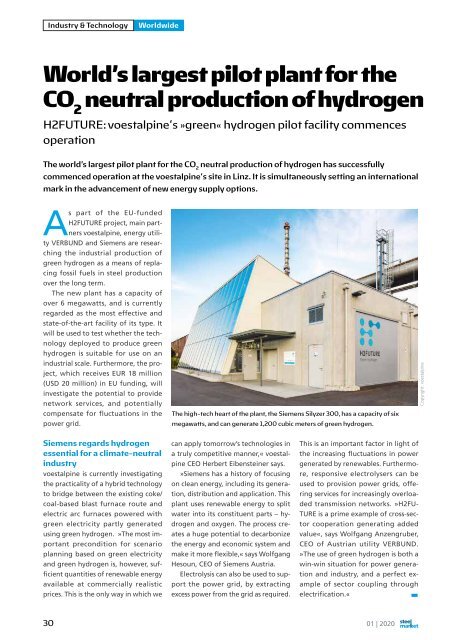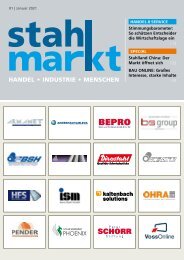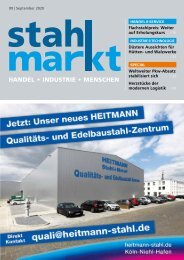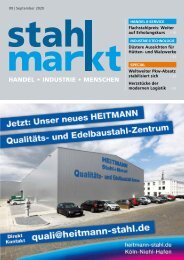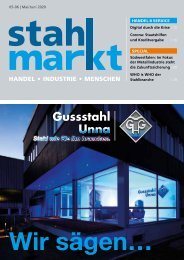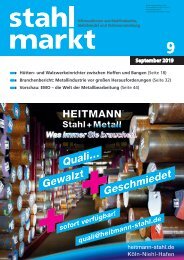Steel Market 01 / 2020
Create successful ePaper yourself
Turn your PDF publications into a flip-book with our unique Google optimized e-Paper software.
Industry & Technology<br />
Worldwide<br />
World’s largest pilot plant for the<br />
CO 2<br />
neutral production of hydrogen<br />
H2FUTURE: voestalpine‘s »green« hydrogen pilot facility commences<br />
operation<br />
The world’s largest pilot plant for the CO 2<br />
neutral production of hydrogen has successfully<br />
commenced operation at the voestalpine‘s site in Linz. It is simultaneously setting an international<br />
mark in the advancement of new energy supply options.<br />
As part of the EU-funded<br />
H2FUTURE project, main partners<br />
voestalpine, energy utility<br />
VERBUND and Siemens are researching<br />
the industrial production of<br />
green hydrogen as a means of replacing<br />
fossil fuels in steel production<br />
over the long term.<br />
The new plant has a capacity of<br />
over 6 megawatts, and is currently<br />
regarded as the most effective and<br />
state-of-the-art facility of its type. It<br />
will be used to test whether the technology<br />
deployed to produce green<br />
hydrogen is suitable for use on an<br />
industrial scale. Furthermore, the project,<br />
which receives EUR 18 million<br />
(USD 20 million) in EU funding, will<br />
investigate the potential to provide<br />
network services, and potentially<br />
compensate for fluctuations in the<br />
power grid.<br />
The high-tech heart of the plant, the Siemens Silyzer 300, has a capacity of six<br />
megawatts, and can generate 1,200 cubic meters of green hydrogen.<br />
Copyright: voestalpine<br />
Siemens regards hydrogen<br />
essential for a climate-neutral<br />
industry<br />
voestalpine is currently investigating<br />
the practicality of a hybrid technology<br />
to bridge between the existing coke/<br />
coal-based blast furnace route and<br />
electric arc furnaces powered with<br />
green electricity partly generated<br />
using green hydrogen. »The most important<br />
precondition for scenario<br />
planning based on green electricity<br />
and green hydrogen is, however, sufficient<br />
quantities of renewable energy<br />
available at commercially realistic<br />
prices. This is the only way in which we<br />
can apply tomorrow’s technologies in<br />
a truly competitive manner,« voestalpine<br />
CEO Herbert Eibensteiner says.<br />
»Siemens has a history of focusing<br />
on clean energy, including its generation,<br />
distribution and application. This<br />
plant uses renewable energy to split<br />
water into its constituent parts – hydrogen<br />
and oxygen. The process creates<br />
a huge potential to decarbonize<br />
the energy and economic system and<br />
make it more flexible,« says Wolfgang<br />
Hesoun, CEO of Siemens Austria.<br />
Electrolysis can also be used to support<br />
the power grid, by extracting<br />
excess power from the grid as required.<br />
This is an important factor in light of<br />
the increasing fluctuations in power<br />
generated by renewables. Furthermore,<br />
responsive electrolysers can be<br />
used to provision power grids, offering<br />
services for increasingly overloaded<br />
transmission networks. »H2FU-<br />
TURE is a prime example of cross-sector<br />
cooperation generating added<br />
value«, says Wolfgang Anzengruber,<br />
CEO of Austrian utility VERBUND.<br />
»The use of green hydrogen is both a<br />
win-win situation for power generation<br />
and industry, and a perfect example<br />
of sector coupling through<br />
electrification.«<br />
•<br />
30 <strong>01</strong> | <strong>2020</strong>


